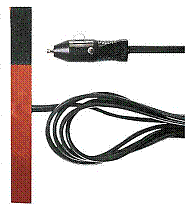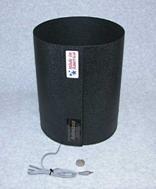In Praise of Dew Zappers
Jack Kramer
Here's the scenario: You're observing on a nice clear evening, and as the night wears on you notice that your telescope tube is pretty wet. Dew! Okay, big deal - but pretty soon you're having a hard time seeing anything through the scope. When you check with a red light you find that dew also covers your eyepiece lenses, or your finder or refractor objective, or your corrector plate. Sound familiar?
Plain old dew shields work pretty well to keep dew off an SCT corrector plate or refractor objective, unless it gets pretty bad. SCT corrector plates have a reputation as dew magnets, so one wonders why dew shields aren't supplied as standard equipment with every SCT. Most refractors come with effective dew shields, but some finder scopes have shields that are too short to do much good. On a Newtonian the objective mirror is generally shielded from exposure to the night sky, plus it has a fairly large thermal mass, so they seldom fog up. A secondary mirror is more exposed, so can present a problem. Fans designed to help objective mirrors reach thermal equilibrium are of questionable benefit when it comes to dew. Fogging occurs when an optical surface is losing heat via radiation to the point that it drops below the ambient air temperature. Moving more air across a primary mirror with the fan will warm the mirror. The fly in the ointment is that you are also moving moist night air across the mirror which gives up its latent heat of evaporation while it condenses as dew!
I struggled with fogged optics for many years. One solution was a 12 volt "dew gun", which temporarily gets rid of the dew, until you have to use it again when the dew reappears. I've had a couple of these; both were sold as auto windshield defrosters that you plugged into the cigarette lighter receptacle. (They didn't work very well for that purpose, and after a few years they went on the fritz.) But many observers use these as a type of dew gun - on a dewy night you could hear a chorus of them whining away in the dark. I haven't seen these types of defrosters sold in the general market anymore, but Orion sells one specifically for astronomers.
The dew gun is inexpensive and effective (for awhile). But far better is a "dew zapper" system that will get rid of dew and keep it away for the duration of your observing time. There are different types. Some are stand-alone heater strips that plug directly into a 12-volt power supply with a cigarette lighter type plug and draw a maximum of 2 amps. These are intended for SCT/MCTs and refractors. The cost varies depending on the length of the heater strip.
 A more elaborate system consists of a controller that plugs into a 12-volt DC power supply and heater strips that wrap around the outside circumference of the optic you want to un-dew. The strips normally attach together with Velcro and are available in different lengths for different purposes. Usually the supplier will indicate which length to use, be it for a 1¼" a 2" eyepiece, or considerably larger for a refractor objective or SCT corrector plate. Controllers vary depending on how many dew strips you can plug into them and whether they have controls to adjust the amount of heat output in each strip. The average Controller costs a little over $100, and the strips vary from about $20 up to around $90, based on their length. One variation is a heater strip integrated into an SCT dew shield.
A more elaborate system consists of a controller that plugs into a 12-volt DC power supply and heater strips that wrap around the outside circumference of the optic you want to un-dew. The strips normally attach together with Velcro and are available in different lengths for different purposes. Usually the supplier will indicate which length to use, be it for a 1¼" a 2" eyepiece, or considerably larger for a refractor objective or SCT corrector plate. Controllers vary depending on how many dew strips you can plug into them and whether they have controls to adjust the amount of heat output in each strip. The average Controller costs a little over $100, and the strips vary from about $20 up to around $90, based on their length. One variation is a heater strip integrated into an SCT dew shield.
 All controllers operate on 12-volt DC and are equipped with plugs for standard telescope power supplies. The heater strips use standard male RCA type plugs that go into the heater control unit. This means that components of various brands all work the same. For example, I have an Astrozap brand controller with which Orion heater strips work perfectly well. The heater strips intended for 2" format eyepieces also fit around the dew shield of my 8x50 finder scopes. Each strip draws fairly low current. With all heater strips operating at their highest settings, the controller draws a maximum of only 5 amps. But if you're using several of them at the same time or at a higher heat setting, after a few nights the system can pretty well draw down a 19 AH battery. But dew zappers do keep your optics from fogging up. My only regret is not having invested in one sooner!
Published in the August 2010 issue of the NightTimes
All controllers operate on 12-volt DC and are equipped with plugs for standard telescope power supplies. The heater strips use standard male RCA type plugs that go into the heater control unit. This means that components of various brands all work the same. For example, I have an Astrozap brand controller with which Orion heater strips work perfectly well. The heater strips intended for 2" format eyepieces also fit around the dew shield of my 8x50 finder scopes. Each strip draws fairly low current. With all heater strips operating at their highest settings, the controller draws a maximum of only 5 amps. But if you're using several of them at the same time or at a higher heat setting, after a few nights the system can pretty well draw down a 19 AH battery. But dew zappers do keep your optics from fogging up. My only regret is not having invested in one sooner!
Published in the August 2010 issue of the NightTimes





